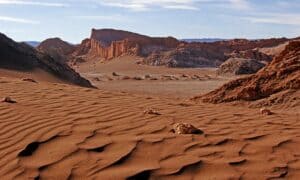Key Points
- Most of Utah’s climate is arid, and around one-third of the state is considered a true desert.
- Most people assume that mountain lions are only found in mountainous regions, but cougars may live in various habitats, including deserts.
- The Mojave green rattlesnake is considered one of the most venomous and aggressive snake species on Earth.
Deserts and Climate in Utah
Around one-third of Utah’s total area is marked by deserts, and the hottest, most dangerous deserts are found in the southern portion of the state. The largest true deserts are the Great Basin region and Canyonlands National Park. Overall, Utah’s climate is arid due to its proximity to mountain chains of the Western United States, as these mountains redirect precipitation in this region.
Moreover, the state averages around 11 inches of precipitation every year. However, precipitation varies greatly according to region. For instance, the Great Salt Lake Desert sees fewer than 8 inches of rainfall annually while the Wasatch Mountains see more than 50 inches of annual precipitation.

Canyonlands National Park is one of the largest true deserts in Utah!
©canadastock/Shutterstock.com
While most of Utah’s dangerous desert animals record small population densities and a small range in their respective areas, they are still formidable and life-threatening creatures. From venomous to violent, Utah’s desert animals are some of the most terrifying in the entire United States. Below is a list of Utah’s top six most dangerous desert animals.
1. Gila Monster
Gila monsters are venomous reptiles that measure around 2 feet long. The coloration of the Gila monster appears black with yellow or orange markings. In addition, their skin is beaded, making them easy to identify. While Gila monster bites are toxic to humans and perhaps as potent as rattlesnake bites, these creatures are rarely encountered by humans.
For one, Gila monsters spend most of their time underground, where they do not encounter humans. In addition, fatalities due to Gila monster bites are uncommon. In fact, human death from a Gila monster bite has occurred in the last century.
Although fatality from a Gila monster bite is rare, humans should be aware of where these reptiles are found, so as not to disturb them. Some primary areas where Gila monsters reside in Utah include the Red Cliffs Desert Reserve, the BLM Red Cliffs recreation area, and Snow Canyon State Park.

Gila monsters rarely encounter or bite humans, but their venom remains toxic and deadly.
©Vaclav Sebek/Shutterstock.com
2. Mojave Rattlesnake
Mojave rattlesnakes, also called Mojave green rattlesnakes or the Mojave green, are venomous snakes found in Utah deserts. The coloration of Mojave rattlesnakes typically appears brown or green, and they feature a rattle at the end of their tail. In addition, Mojave greens record a length between 3.3 and 4.5 feet. These snakes may also display a pattern on their back like that of the western diamondback rattlesnake.
The venom of the Mojave rattlesnake is both hemotoxic and neurotoxic, meaning it targets the nervous system and the circulatory system. Therefore, a bite from a Mojave green can break down certain bodily functions, such as blood clotting or voluntary muscle movement. Luckily, Mojave green rattlesnakes are not prevalent throughout the entirety of Utah. Rather, they are secluded to the very southwest corner of the state, meaning that a human confrontation with a Mojave green is rare.

Mojave green rattlesnake venom is both hemotoxic and neurotoxic.
©iStock.com/Shoemcfly
3. Arizona Bark Scorpion
Arizona bark scorpions are another example of a venomous creature found in Utah deserts. Like Mojave green and Gila monster encounters, Arizona bark scorpion encounters in this state are rare. These creatures reside in the southeastern portion of the state, particularly in Kane County. However, Utah residents should be aware of the dangers of these scorpions because they may invade homes.
When Arizona bark scorpions seek shelter, they do not burrow into the sand or dirt like other animals. Rather, they find shelter that already exists, such as in a home or under rocks and tree bark. In fact, the term “bark” in the scorpion’s common name derives from its tendency to conceal itself under tree bark. In addition, these creatures usually measure between 2.75 and 3.15 inches long. Furthermore, males usually record greater lengths than females.
The venom of the Arizona bark scorpion is toxic to humans and can cause several effects on the body. For one, this scorpion’s stings may result in intense pain, numbness, vomiting, and temporary paralysis. In addition, these effects can remain for up to three days.
While fatalities from Arizona bark scorpion stings are rare, some groups are more vulnerable than others. These groups include children, elderly people, and adults with prior immune disorders or medical conditions. Therefore, stung humans should seek medical attention immediately, as the Arizona bark scorpion’s venom is extremely potent.
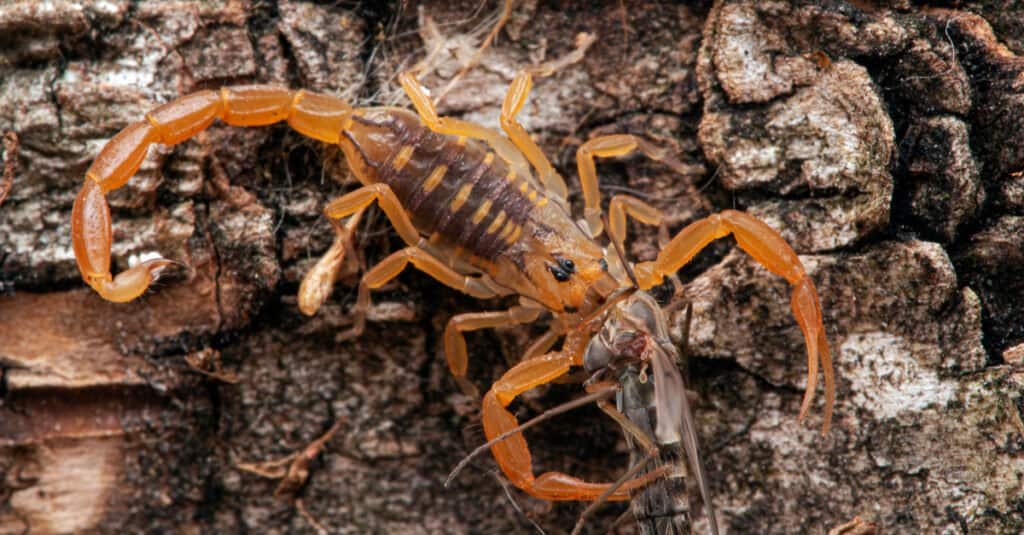
Arizona bark scorpions may seek shelter in homes, making them extremely dangerous to humans.
©Ernie Cooper/Shutterstock.com
4. Cougars
While most people encounter cougars in mountainous regions, they may also reside in the deserts of Utah, particularly in the southern region of the state. Despite their wide distribution, cougars typically record few individuals in any given location. They reside in a variety of habitats throughout Utah but record low population densities in each. Although their population numbers may be few in Utah’s deserts, they remain one of the most dangerous animals in the state.
Cougars are ambush predators, meaning they stalk their prey and pounce on them when the prey is vulnerable. In addition, cougars are stealthy, and by the time a human recognizes a cougar in the wild, the cat will already have an advantage. Cougars make themselves known as they strike prey, making them nearly undetectable and highly dangerous.
In addition, cougars possess various features and qualities that are dangerous to human life. For one, these cats can weigh up to 220 pounds and record speeds of up to 40 miles per hour. In addition, the bite force of a cougar measures over 400 PSI, meaning their jaws are relatively powerful. Cougar teeth may measure around two inches long, and their claws record a length of approximately 2.5 inches. Finally, when cougars attack, they use their forelegs to wrap around prey and hold it down on the ground. Therefore, these cats can immobilize a victim before it has the chance to fight back.
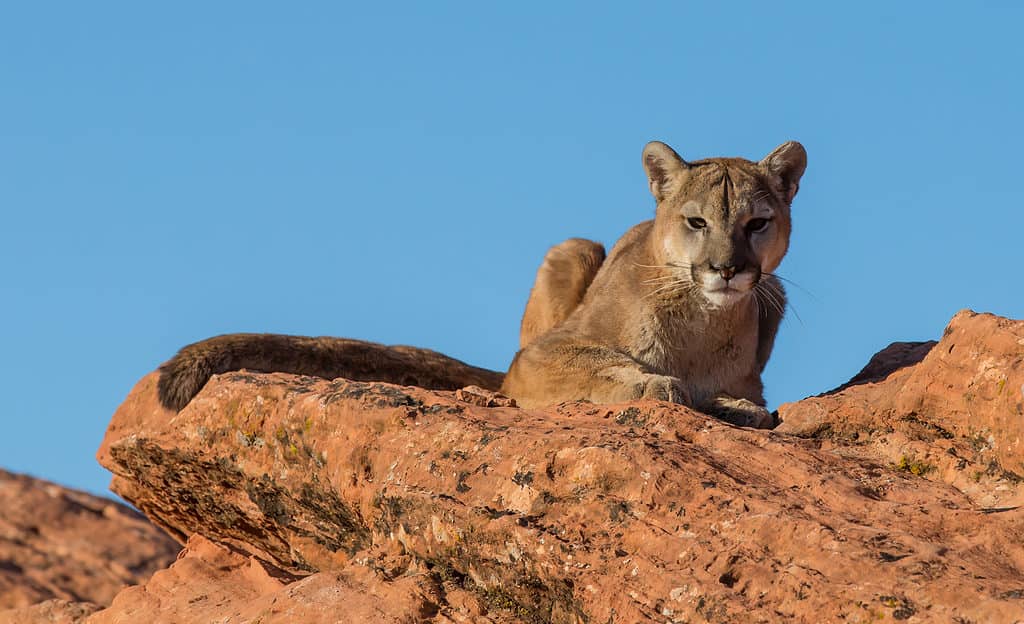
Cougars record a bite force of 400 PSI!
©Warren Metcalf/Shutterstock.com
5. Sidewinder Rattlesnake
The sidewinder rattlesnake derives its name from its unique way of crawling, which is called “sidewinding.” Sidewinding helps this snake slither across loose dirt or sand quickly and effectively. In addition, this rattlesnake is a type of pit viper that averages around 20 inches in length. However, some sidewinder rattlesnakes may record lengths of more than 30 inches!
Sidewinders are venomous snakes found in deserts across North America and the Middle East. In Utah, these snakes reside in the very southwest corner of the state. Furthermore, these snakes may also be referred to as Mojave Desert sidewinders. This rattlesnake’s venom is hemotoxic, meaning it targets the blood and tissues of the body. While sidewinder venom is toxic to humans, it is not as potent as the venom of the Mojave green rattlesnake, making the sidewinder less dangerous but still threatening.
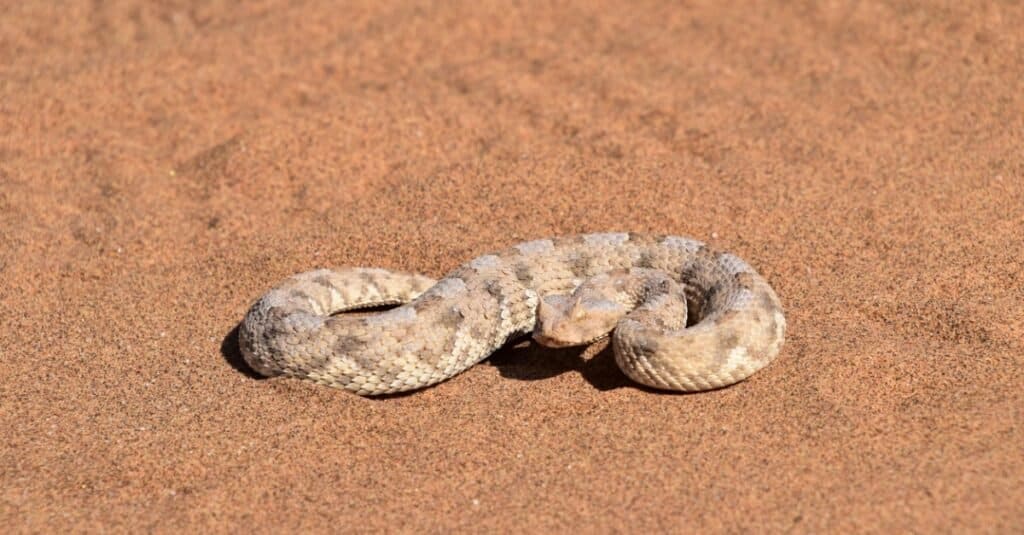
The sidewinder rattlesnake derives its name from its unique way of traveling across loose dirt or sand.
©iStock.com/Josh Mitchell
6. Desert Recluse Spider
The desert recluse spider is often confused with the brown recluse spider. However, brown recluse spiders do not exist in the state of Utah. On the other hand, desert recluses are found in Washington County, Utah. Desert recluses, although, may exhibit similar behaviors as the brown recluse. They often hide in homes, buildings, vents, attics, under rocks, or in woodpiles. Desert recluse coloration usually appears tan, and they have six eyes, while most spiders possess eight.
In addition, desert recluse spiders are venomous, and bites result in severe side effects. Some effects of a desert recluse bite include cramps, headaches, vomiting, extreme pain, and nausea. Moreover, the bitten area experiences necrosis, where flesh and tissue around the bite begin to die. Over time, the skin may turn dark and fall off, and the bite may take weeks to fully heal.
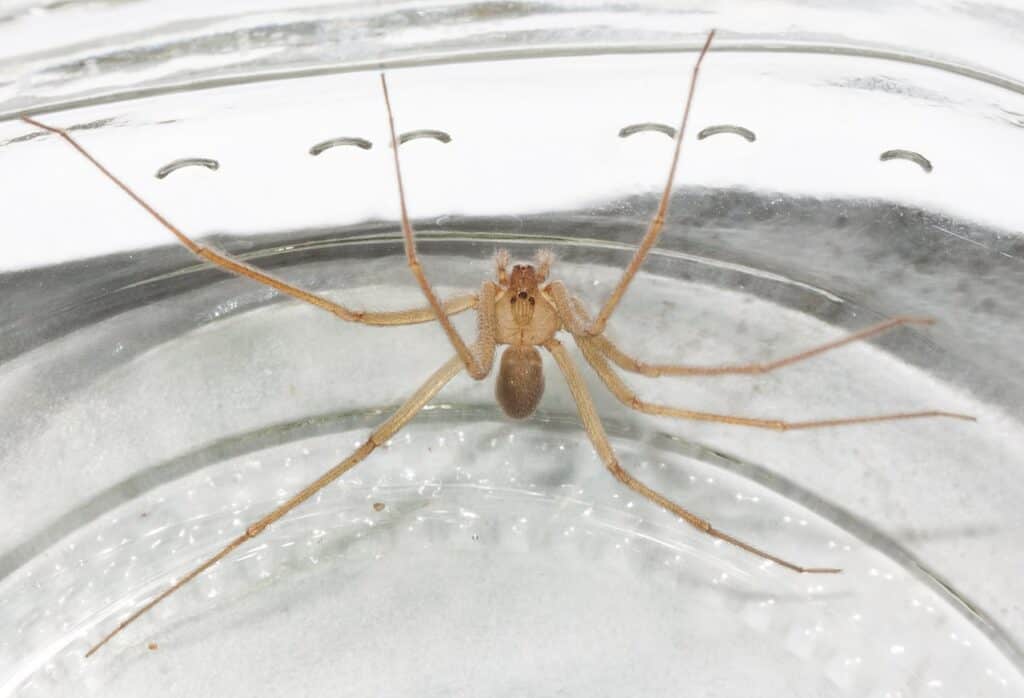
Desert recluse spiders only have six eyes, as opposed to eight, making them easy to identify.
©DesertTrip / CC BY-SA 4.0, via Wikimedia Commons – Original / License
The photo featured at the top of this post is © Vaclav Sebek/Shutterstock.com
Thank you for reading! Have some feedback for us? Contact the AZ Animals editorial team.




